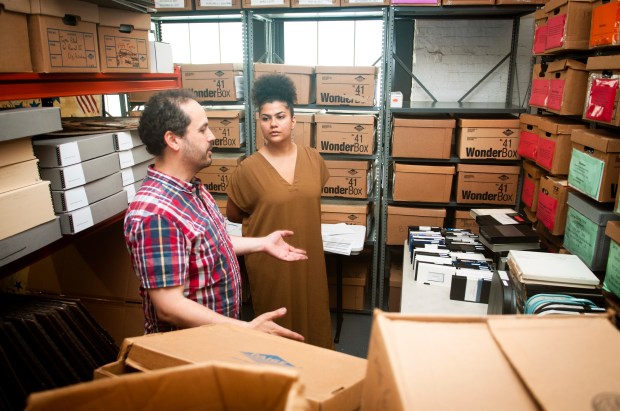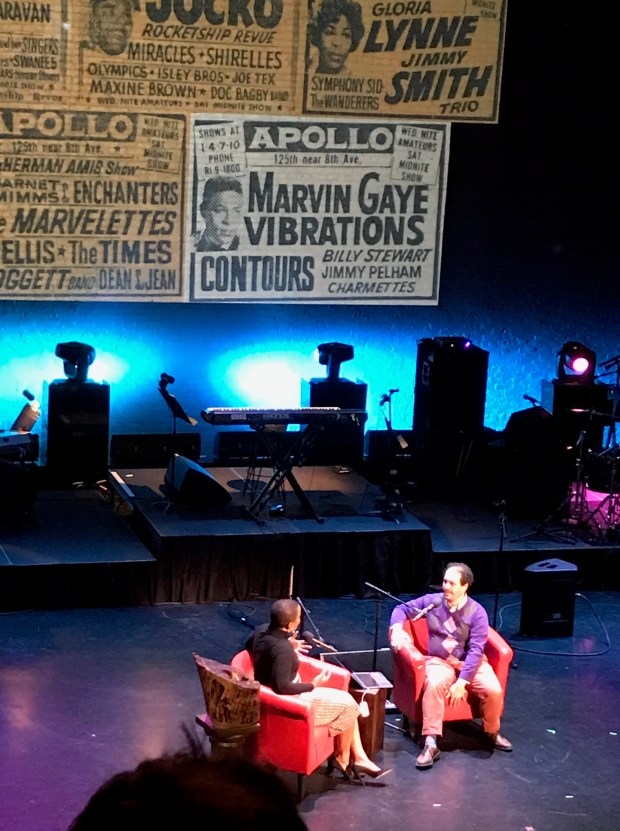This is the latest post in our There’s an Archivist for That! series, which features examples of archivists working in places you might not expect. In this entry, Committee on Public Awareness (COPA) member Rachel Seale brings you an interview with Brad San Martin, Digital Archivist for Harlem’s Apollo Theater.

Brad San Martin. Photo credit Amber Duntley (www.flickr.com/adunt).
Prior to entering the archives field in 2015, Brad San Martin worked in the music and travel industries as a copywriter, content developer, and product manager, among other roles. He has also produced and/or annotated a number of acclaimed historical CD reissue projects, including Kevin Dunn’s No Great Lost: Songs 1979-1985 and Harlan County USA: Songs of the Coal Miner’s Struggle.
How did you get your gig?
I arrived at the Apollo after spending most of my professional life working in the music industry in a few different — including publicity, radio promotion, project management, copywriting, and artist relations — capacities. While in that world I had overseen several archival releases, compiling new CD collections from old tapes, researching the best available sources, clearing the rights, annotating them, and so on. Putting projects like those together inspired me to explore archives as a full-time pursuit. So, eighteen years or so after I finished undergrad, I went back to grad school to get my master’s degree in Library Science with a concentration in Archives. Throughout grad school I worked processing audiovisual materials at the Southern Folklife Collection, which was an incredible opportunity to learn about the nitty gritty of archiving and about the variety of media formats that are out there. I thought I knew them all…
When this position came across my radar, I was thrilled: What fan of popular music hasn’t been affected by an artist, a song, or a movement that was forged onstage at the Apollo? Being here feels like the culmination of everything I’ve been doing before — and it draws from all areas of my experience.
Tell us about your organization
The Apollo Theater takes inspiration from the rich legacy of the theater’s past in order to enrich the future. Through its education department, the theater introduces young people to the incredible contributions that have emerged from Harlem and the Apollo, while also offering students opportunities to learn about what goes on behind the scenes: production and tech, publicity, programming, and more. The Apollo is also positioning itself as a catalyst for a new canon of works, producing and presenting provocative, powerful new pieces of theater, dance, and music.
I always like to stress that while the Apollo has a remarkable backstory, what our programming team is doing now is every bit as vital. And being the archivist means that I get the best of both worlds: I get to help document the new programs we develop while also watching over the materials that allow us to tell the story of the theater’s history.
Describe your collections
The Apollo Theater Archives is a new initiative. I have been here for just about a year and a half now. The fact that I am here at all is a testament to the long-term vision of the Apollo’s past and present leadership — people like Laura Greer and Mikki Shepard, who kept the torch for the archives burning for years before I arrived. Over the past fifteen years, whenever funding was available, portions of the collection were inventoried and preserved. So when I got here, there were a mix of processed and unprocessed collections, in various stages of preservation.

Photo by Megan Rossman. Working with Smith Fund intern Samantha Scott to arrange A/V materials in the Apollo’s collection.
The Apollo collection spans pretty much every conceivable audiovisual format, in addition to photographs, posters, program booklets, three-dimensional artifacts, ticket stubs and passes, and business records. In the mid-1980s, the Apollo had full broadcast and audio recording studio facilities, and as a result we have a lot of ¾” and open-reel video from both the theater and recorded for production clients. One of the most informative and illustrative areas of the collection is a set of more than 2000 hand-tinted photographs of artists who performed at the Apollo from the 1950s through the 1970s. Taken as a set, they tell us so much about who worked here — and not just the big stars, who are certainly represented, but the ventriloquists, the dancers, the MCs, the animal acts, and others who may have otherwise been forgotten.
What are some challenges unique to your collections?
We face the same challenges that other largely audiovisual collections contend with: obsolete formats, unclear rights provenance, storage and preservation issues, et cetera. The Apollo is a working theater in Manhattan, so on-site storage space is at a premium. One of the biggest issues we face is that there is no way the collection can match the formidable legacy of the Apollo. People imagine a goldmine of photos, video, handbills, and posters documenting every one of the thousands of shows that happened here. But the Apollo was a working, for-profit theater for most of its life — people were too busy getting paying customers into the seats to prioritize creating a historical record.
With that in mind, the collection is also not continuous: We have elements from all eras of the theater’s 85-year existence, but not all eras are represented evenly. A number of materials related to the theater were donated to the Smithsonian by the theater’s former owners. But thanks to the growing capacity of digital tools, we’re able to partner with other institutions and share certain items digitally, enriching our holdings and what we will eventually be able to offer potential users.
Speaking of users, the Apollo Theater Archives are not yet open to the public — so it’s also a challenge for me to ask interested people to wait while we catalog, digitize, and preserve the materials in the collection in preparation for them to be accessed.
What is the favorite part of your job?
I’m incredibly fortunate to be able to discover new objects related to the theater’s history and performances on a very regular basis…but even more exciting is seeing the elements of the collection utilized on behalf of the Apollo Theater’s missions. We preserve these things for a reason, and that’s to share them. So watching them become a part of an educational or community program, or referenced by a visiting artist who is working to create a new work, is incredibly fulfilling.

Photo by Lisa Mullins. Presenting materials with WNET’s Jenna Flanagan from the Apollo Theater Archives on stage at the Apollo’s annual Open House event, February 2, 2019.
That said, the best part of my job is continuing to discover just how much the Apollo means to people — especially those with roots in Harlem. The theater has been more than a performance venue: It’s a pillar of an incredibly vibrant, dynamic community. I see the theater’s role in people’s lives most vividly through our community events, which engage a largely local audience in conversations about history, culture, and politics. The delight and appreciation they express when they discover that we’re working hard to preserve and extend the legacy of a place they love so much is overwhelming.
Stay tuned for future posts in the “There’s an Archivist for That!” series, featuring stories on archivists working in places you might not expect. If you know of an archivist who fits this description or are yourself an archivist who fits this description, the editors would love to hear from you—share in the comments below or contact archivesaware@archivists.org to be interviewed for ArchivesAWARE!
